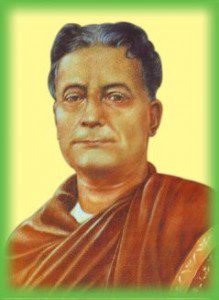Lakshminath Bezbaroa was a powerful representative of the creative and intellectual resurgence of modern India. His was the Assamese version of resurgence of emotions, thoughts and imagination that sprouted and bloomed in different parts of India during the nineteenth century. His works represented the contemporary modern Assamese mind through which streamed forth a reawakening of the language, literature, culture and society of Assam. His literary journey was inextricably associated with the Assamese upswing for self-assertion and establishment and his enterprising representation for an entire period between 1890 to 1938 as a story-writer, poet, lyricist, novelist, playwright, biographer, essayist and editor of a journal has come to be regarded as the ‘Bezbaruah Yug’ (Bezbaruan Period).
The Kamrupi language (dialect) was much in vogue in the production of early Assamese literature. The Ahoms, who entered Assam in 1228 A.D., were in favour of the Kamrupi script in the early stages along with the Tai language in issuing their royal edicts. Their chronicles known as the Buranjis, though written in stilted Assamese, remains the greatest literary contribution of the 600-year-old Ahom period. Towards the end of the thirteenth century, Hem Saraswati and Harihar Bipra wrote narrative poems in Assamese and they along with Rudra Kandali, Kabiratna Saraswati and Madhab Kandali dominated the literary arena of 14th century Assam. The language used by the poets show that Assamese, apart from attaining a distinctive identity of its own, had also acquired the grace for the expression of classy literature. Madhab Kandali’s poetic diction bears testimony to an inheritance of a long literary tradition. The language of this period matured with glory in the hands of the celebrated Vaishnavite poets, Sankardeva (1449-1568) and Madhabdeva (1489-1596). Ananta Kandali and Ram Saraswati followed suit. Bhagawat Bhattacharya alias Bhattadeva (1558-1638) translated the ‘Bhagavata’ and the ‘Gita’ in colloquial prose and the language began to gain precedence. Bhattadeva’s prose went on to influence the textual language of the Charitputhis (biographical sketches of the lives of the saints) written in the sixteenth century. Shah Miran or Ajan Fakir (b.1610) composed jikirs and jaris bearing a spiritual tone and content. The intimate flavour of the language helped in spreading the message of peace. The philosophical depth in simple-sounding lines as ‘Waters die of thirst, fires die of cold’ is poetry at its splendid best.
Following the treaty of Yandaboo in 1826 when Assam came under British subjugation, the Baptist missionaries arrived with the primary objective of preaching their religion. They had the Bible translated into Assamese by Atmaram Sharma but its quaint language failed to generate the desired impact. They eventually realised that the masses could be reached most effectively only through the language prevalent among the local people. In 1846 they launched the first Assamese journal, Arunoday the language of which caught the interest of the pioneers of post-Ahom Assamese prose — Anandaram Dhekial Phukan, Gunabhiram Barooah and Hemchandra Baruah. Besides the trio, many others wrote consistently in the Arunoday. For the aspiring and promising students of Assam Kolkata was the most sought-after centre for higher studies where the western literary trends, reflected in Bangla literature, prevailed upon them. An intense nationalist impulse found a marked expression in the fiery impassioned verse of Kamala Kanta Bhattacharya (1854-1936) who, too, had begun his literary career through the Arunoday.
The age of modern Indian literature sprouted with the assimilation of the oriental and the occidental after the country’s emergence from colonial domination. The literary ventures of Hemchandra Baruah and Gunabhiram Barooah followed by those of Chandra Kumar Agarwalla, Rajanikanta Bordoloi and others laid the foundation in this aspect in Assamese.
Lakshminath Bezbaruah spent more than thirty years in Kolkata after his matriculation in 1886. During this period there was obviously a deep impact of the language, literature, culture and society of Bengal on him. This impact can be well imagined during his formative phase of intellectual development and association with the Tagore family (with the towering personality of Rabindranath at his peak) following his matrimonial alliance in 1891 with the Kaviguru’s niece, Pragyasundari Devi. But nothing deterred him from striving for the development of the language and literature of his homeland. His enthusiasm never waned with any form of mental subordination. Contrarily, his resolve doubled for materialisation of his dream. Despite his strenuous engagement in a business like timber trade, he amazingly managed to churn out consistently a wide variety of literary output and that too with a diction and dimension that was to set a trend for generations to follow or base upon.
The Asomiya Bhasa Unnati Sadhini Sabha came into being at Kolkata and in 1889 Lakshminath Bezbaruah and his associates of the famous triumvirate (Trimurti) — Chandra Kumar Agarwalla and Hemchandra Goswami launched the celebrated monthly literary journal, Jonaki. The specific objectives of the journal were exaltation of the stature of the Assamese language;enriching of Assamese literature with new thoughts, ideals, subjects and form; reformation of Assamese society; and rediscovering the wealth and beauty ingrained in Assamese tradition and folklore.
Bezbaruah began his literary journey with a light but good-humoured play entitled ‘Litikai’ (The aide) in 1890. He began to show his deft hand in all genres of literature. His proficiency surfaced as an able novelist, poet, lyricist, playwright, essayist, biographer, translator and editor. His remarkable sense of wit and humour that mingled with his literary outpourings defined a distinct class of its own. His belles-lettres — ‘Kripabor Baruar kakator topola’ (1904) and ‘Kripabor Baruar Ubhatoni’ (1909) generated a great deal of amusement and enlightenment among the people. His satire and typical humour shook the prevalent Assamese mind-set. His collection of verse entitled ‘Kadamkali’ (Lotus buds) published in 1913 bear ample testimony of his poetic accomplishment. An edited version of his lyrics, ‘Mor desh’ (My motherland) has been accepted unanimously as the anthem of Assam. One of the poems in the collection, ‘Brinda-Chandrawali Sangbad’ is interspersed with Hindi words and a number of lines in English that provide a casual tone and flavour to the poem. What is worth-noting is that Bezbaruah’s proficiency in the English language comes to the fore as explicit in the lines —- ‘Awful naughty that boy……’, ‘steal the flute, pay back in his own coin’, pray have no nonsense’. Whether the verses be serious or humorous in content, there is no space for pessimism or lamentation in any of them. He solicited the advancement of mankind amidst the joys and sorrows of life, human strengths and foibles with full hope of the brightest of futures.
His novel ‘Padum Kunwari’ (Lotus princess) published in 1905 and narrated with a fragrant tinge of lyricism is replete with a strong patriotic fervour. His collections of stories include the immensely popular ‘Burhi air xadhu’ (Granny’s tales), ‘Kokadeuta aru natilora’ (Grandpa and grandson), ‘Surabhi’, ‘Junuka’, ‘Jonbiri’ etc. published between 1909 and 1913 which still continue to enthral the young and old alike. The fascinating tales and stories generate the message of peace and arouse the feelings of compassion and empathy among readers. His plays like ‘Joymati Kunwari’, ‘Chakradhwaj Singha’ and ‘Belimar’, all published in 1915, are exclusively historical depicting glorious episodes of the history of Assam. With a superb portrayal of the moments of pathos he demonstrates the rise and fall of kingdoms and personalities convincingly. The first Assamese film, ‘Joymati’ made by Jyotiprasad Agarwalla in 1935 is an adaptation of Lakshminath Bezbaruah’s play, ‘Joymati Kunwari’. Bezbaruah’s biographies, ‘Sankardeva’ (1911) and ‘Sri Sankardeva aru Madhabdeva’ (1914) emphasised the strong roots of Assamese culture and the contribution of the socio-cultural and literary genius in unifying Assamese society and bringing about a spiritual, cultural and literary enlightenment of the masses through the medium of art and culture. Bezbaruah, through the biographies, sought to bring the luminaries out of the supernatural confines and instal them in every Assamese heart. He also wrote a biography on his father entitled, ‘Dangoria Dinanath Bezbaruah’ published in 1909. ‘Mor Jivan Suwaran’ (Reminiscences of my life) is his autobiography published in 1941 with heart-touching illustrations of a part of his life spanning thirty-five years with moments of elation and dejection. Apart from being a narrative of his life and the philosophy that he upheld, the autobiography throws light on the cultural tradition and natural ambience of Assam. His translated work, ‘Bharatbarshar Buranji’ (History of India) published in 1906 bears testimony to his historical awareness and consciousness. Bezbaruah edited the journal ‘Banhi’ (The flute) between 1910 and 1935 and succeeded in stirring the latent creative urge in the Assamese minds and hearts. The satirical and inspirational contents of the journal contributed immensely in creating awareness among the people and cautioning them against idleness which is a granary of perpetual despair. Bezbaruah’s presidential speech in the Asom Sahitya Sabha session at Guwahati in 1924 is replete with invaluable aspects of language, culture, society, integration and assimilation from his distinctive angle of view. He also delivered a memorable speech on the philosophy of Vaishnavism at Baroda in 1933 on being invited by the Maharajah of Baroda. The speech was published in book-form in 1969 as ‘The religion of love and devotion’.
Bezbaruah’s creative faculty, consciousness and foresightedness were enriched by his immersion in the essence of a wide variety of literature ranging from ancient Sanskrit to the latest output from the west. His mind was constantly haunted by the dream of having the language and literature of his land established firmly at an elevated and enviable height whereby the Assamese identity, too, could attain a pedestal of pride. Lakshminath Bezbaruah was able to identify the nuances and intimate characteristics of the Assamese language with which he could venture upon a new style of prose where emotion merged with the intellect. He believed that the literature of any region gained more from the unearthing of folk roots than the translations from foreign literature. Bezbaruah strove to set a trend with a distinctive elegance and appeal and what he delivered is history with a class apart, a heritage that continues to energise and enliven his succeeding generations.
Reference:
- History without shadows — significant moments of Assamese literature (The Book Review;Vol.XXI, No.4 / North East) : Prof. Pradip Acharya
- Asomiya Sahityar Samikhyatmok Itibritti : Dr Satyendranath Sharma
- Bezbaruar Nirbachita Rasana : compiled by Dr Nagen Saikia
Krishna Dulal Barua has been consistently translating poems, short- stories and literary articles from Assamese to English. His ‘Selected poems of Nilmani Phookan’ published by the Sahitya Akademi appeared in 2007.He received the Katha Award for translation in 2005.




Leave a Reply